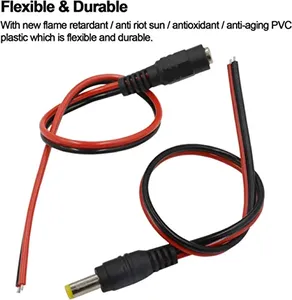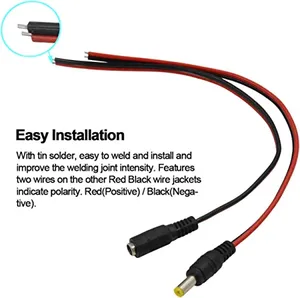(6485 products available)












































































































































































Also known as ignition cables or high-tension leads, spark plug cables are an important part of the vehicle's ignition system. Their main purpose is to deliver electric current from the ignition coil to the engine's spark plugs, enabling the engine to start and run smoothly. Spark plug cables come in different types, which include:
Resistor Spark Plug Cables
Even though they are not as common as before, you can still find resistor spark plug cables. These cables have a resistor built into their core. The resistor works to reduce the amount of electrical noise that is generated when the vehicle is running. This electrical noise could interfere with the radio signals, leading to poor reception. As a result, users get a smoother ride without having to deal with static from the radio.
Carbon Fiber Cables
Carbon fiber cables are a great option for people who want high performance without breaking the bank. The carbon core is wrapped in a mixture of copper and graphite. This combination gives the cables a long lifespan while also providing good conductivity. As a result, the engine gets the right amount of power to run optimally, without missing or stalling.
Copper Wound Cables
For those who want the best of the best, look no further than copper-wound cables. These cables are made with a copper core, which is the best material for conducting electricity. The high conductivity ensures that the current flows smoothly from the ignition coil to the spark plugs. As a result, the engine gets an even and consistent spark. Whether one is driving on the highway or towing a trailer, the engine always has the power it needs to get the job done.
Silicone Insulated Spark Plug Wires
Silicone-insulated spark plug wires are designed to withstand extreme heat. They are made with high-quality silicone material that has a high heat tolerance. This makes them ideal for use in modern vehicles that have high-performance engines. The wires can last longer, even when exposed to high temperatures. This means that the ignition system will continue to work properly for many miles, reducing the need for frequent replacement.
High-Performance Spark Plug Wires
High-performance spark plug cables are designed for racing cars or vehicles with modified engines. They have a low-resistance core, which allows them to handle high levels of electrical current. As a result, the spark is stronger and more consistent. The engine runs smoothly, even at high speeds or under heavy loads. Additionally, the cables are often made with advanced materials, such as aramid blends, to improve durability.
There are several specifications for plug cables that make them suitable for various vehicle engines. They include the following:
Conductor
As the name suggests, a spark plug cable conducts electricity from the ignition coil to the spark plug. It has a conductor that makes this possible. Depending on the type of spark plug cable, the conductor can either be copper or carbon. Copper is a good conductor of electricity, meaning it can carry electric current with ease. On the other hand, carbon is not as efficient as copper, but it has the advantage of being more durable and resistant to wear and tear.
Insulation
Insulation is a crucial specification of a spark plug cable. Insulation helps to ensure that high voltages are not lost and that the voltage does not leak, which could interfere with the functioning of the engine. Different materials are used for insulation, including silicone rubber, PVC, and EPDM. Silicone rubber is popular because it has excellent heat resistance, flexibility, and durability.
Resistance
Different spark plug cables have different resistances. Resistance in a spark plug cable is measured in ohms. It helps to control the amount of electric current flowing through the cable. High-resistance cables are suitable for older vehicles that use a high current for ignition. For modern vehicles, low-resistance cables are ideal since they use a low current for ignition.
Length
Different vehicles require spark plug cables of varying lengths. The length of the cable is an important aspect to consider when selecting a plug cable. The cable should be long enough to connect the ignition coil to the spark plug without any interference or disruption.
Termination
The end of the spark plug cable is called termination. It is an important specification because it affects the connection between the cable and the ignition coil and the spark plug. Depending on the type of engine, the termination can either be a straight style or 90-degree style.
When it comes to maintenance, users are advised to inspect the spark plug cables regularly for any signs of wear and damage. They should also ensure that the cables are correctly installed to avoid any interference with their functioning. Proper installation also ensures that the cables do not get damaged by other engine components. Carbon-based cables should be cleaned regularly to maintain their efficiency.
There are several factors that buyers need to consider when purchasing spark plug cables. They include:
Vehicle requirements
It is essential to consider the vehicle's make, model, and year of manufacture. This is because the vehicle's specifications determine the spark plug cable requirements and the correct length and fitment of the cables.
Heat resistance
Consider spark plug cables that have high heat resistance. This is because they can withstand extreme temperatures in the engine compartment without degradation.
Electrical conductivity
Electrical conductivity is a vital factor to consider when buying spark plug cables. This is because high-quality cables with superior electrical conductivity provide a more reliable spark and improve engine performance. Buyers can measure the electrical conductivity of the cables using a multimeter.
Durability
Buyers should purchase spark plug cables that are durable. Such cables can provide long service without failure. The cables' durability can be influenced by the material and construction.
Compatibility with ignition systems
Buyers should consider spark plug cables that are compatible with different ignition systems. This is because vehicles with high-performance engines and coil-on-plug ignition systems require specialized cables. Such cables have a short length and are designed for direct connection between the spark plugs and the ignition coils.
Brand reputation
Buyers should consider reputable brands when purchasing spark plug cables. This is because reputable brands produce high-quality cables that meet industry standards. Additionally, reputable brands offer warranties and after-sales services.
Price
Buying buyers should purchase spark plug cables that are within their budget. However, they should avoid extremely cheap cables. Such cables may be of poor quality and may not provide the required performance.
It’s very easy to replace a spark plug cable, and a mechanic is not necessarily needed. Below are the steps on how to replace a spark plug cable:
Firstly, to replace a spark plug cable, one needs to have the following tools:
Steps to replace a spark plug cable
Q1. How often should a spark plug cable be replaced?
A1. There is no definite time to replace spark plug cables. This is because their durability depends on several factors. However, users should inspect the cables for any signs of wear or damage. If they notice any, the spark plug cables should be replaced immediately.
Q2. Can someone install a spark plug cable themselves?
A2. Yes, but only if they follow the correct procedures and instructions. Replacing a spark plug cable is a simple task that anyone can do. Even without any prior experience, people can be able to change a spark plug cable. They just need to look up a tutorial online or read the car's manual.
Q3. What is the difference between a spark plug cable and a battery cable?
A3. A spark plug cable carries high-voltage current from the ignition coil to the spark plugs. It is part of the ignition system. On the other hand, a battery cable transfers low-voltage current to and from the battery. It is part of the electrical system.
The web search volume for the keyword "spark plug cable" shows a monthly average of 18,100 web searches. Over the past year, there has been a notable fluctuation with a one-year change of 22%. However, within the last three months, the web search volume has dipped by 18%. Analyzing the 12-month data, the keyword experienced its lowest web search volume in the months of November through February, each recording 14,800 web searches, before rising steadily to a peak of 22,200 web searches in August.
A closer look at the trend reveals a pattern of seasonal variation in web search volume for "spark plug cable." The lowest interest period from November to February possibly correlates with the end of the automotive repair season in many regions, where colder weather discourages vehicle maintenance activities. Conversely, the spike in August could be attributed to the beginning of the vehicle maintenance cycle, as individuals prepare their cars for the end-of-summer road trips and anticipate the onset of colder months.
The data suggests that the web search volume for "spark plug cable" is highly influenced by seasonal trends, which could be indicative of consumer behavior patterns related to vehicle maintenance and preparation for seasonal changes. This insight could be crucial for businesses in the automotive parts sector for planning inventory and marketing strategies aligned with these observed search trends.